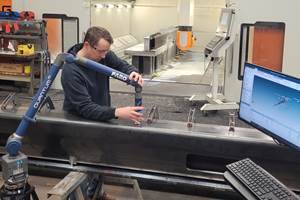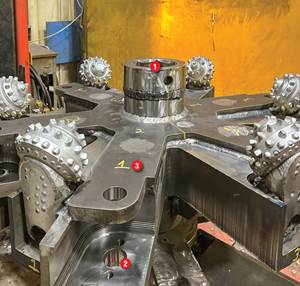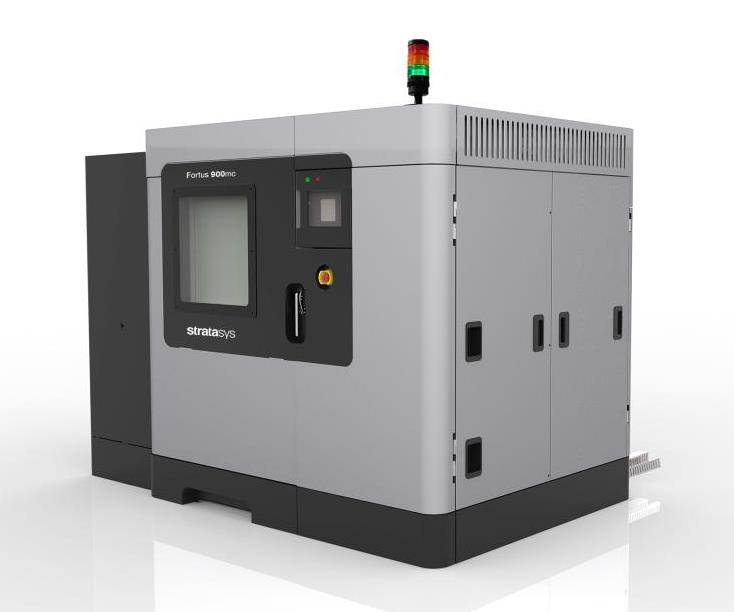How a Custom ERP System Drives Automation in Large-Format Machining
Part of Major Tool’s 52,000 square-foot building expansion includes the installation of this new Waldrich Coburg Taurus 30 vertical machining center.
Share

Part of Major Tool’s 52,000 square-foot building expansion includes the installation of this new Waldrich Coburg Taurus 30 vertical machining center. Source: All photos provided by Major Tool & Machine.
In the mid-1990s, Major Tool & Machine (MTM) began a transformative journey that saw paper-based shopfloor processes scrapped in favor of a fully integrated electronic approach. The journey began with an ERP system then known as Visual Manufacturing, a system that eventually became the backbone of MTM’s operations, encompassing everything from financials to machining and detailed shopfloor activities.
The system is consistently updated and customized to MTM’s operational framework, methodically inserting checkpoints and automation into every step of planning and production. The result? A 98% on-time delivery rate for some of the most complex large-format machining operations imaginable.
Another result? Our selection of Major Tool and Machine as our 2024 Top Shops honoree in the category of Shopfloor Practices. Here’s why.
A Legacy of Precision and Scale

Major Tool’s automated Parpas flexible manufacturing system (FMS) cells is served by rail-guided vehicles and integrated Zeiss CMMs.
Based in Indianapolis, MTM has been at the forefront of large-format machining since 1946, serving industries where accuracy and on-time delivery are paramount. The company produces complex, large, high-precision parts — parts that are measured in feet and tons rather than pounds and inches — for industries ranging from aerospace and defense to semiconductors and nuclear power.
The large-scale components MTM produces today are often machined from solid blocks of aerospace-grade materials like titanium, Hastelloy, and Inconel —materials that can quickly degrade tools and, if not managed carefully, result in expensive scrapped parts. From submarine components for the U.S. Navy to massive, complex structures for high-NA EUV lithography chip making systems, MTM is often required to hold tolerances within a few thousandths of an inch true position across massive dimensions. Holding those tolerances and achieving on-time delivery requires both state-of-the-art machine tools and an ERP system that automates and controls each step of production.

A Gruppo Parpas XS 20.4, five-axis gantry mill, seen here, is air-cooled to prevent expansion and contraction during long cutting passes.
Kevin Bowling, Chief Operating Officer of MTM, says that the transformation here was first made possible by owning and customizing the ERP’s source code, which allowed Major Tool to create specialized modules tailored to their manufacturing niche. These modules have been integrated into MTM’s custom ERP system to manage quality, planning, execution, and data inspection processes within a single, unified platform. Critically, much of this planning happens before any work hits the shop floor. This includes everything from defining CNC programs or welding operations to tracking material flow and configuration management.
Navigating Logistical Challenges

Major Tool’s campus — show here prior to its ongoing expansion — occupies nearly 700,000 thousand square feet.
Walking through MTM’s vast campus, it’s hard not to be impressed by the sheer size and scale of the company’s production operations. Everything here is big and sprawling and seemingly fraught with logistical challenges, like the time a few years ago when company leadership had to convince local government to allow Major Tool to purchase an adjacent road to accommodate MTM’s oversized trucks.
Major Tool’s five plants — with a 52,000 square-foot expansion underway — are packed with state-of-the-art CNC equipment, including more than 45 machine tools with several that boast X-axis travel capabilities of more than 60 feet. The company employs 427 workers and operates three shifts, seven days a week.
Despite the significant capital investments in state-of-the-art equipment, it was the implementation of advanced software systems that streamlined MTM’s operational controls. From automating gage calibration checks to implementing checkpoints on task assignments for properly trained workers, it is the software that maintains the critical flow of operations. For example: Through a badge scan, the software will detect if welder is not certified for a specific welding process that is required by the U.S. Navy. If that happens, the employee might have to perform a test weld on a coupon plate. That plate will have to be X-rayed and inspected before the employee regains qualification. Until then, the worker physically won’t be allowed to pull the filler metal and perform the operation.
“This is a software system that helps us manage floor level activity that traditionally would be managed by a list,” Bowling says. “Under those conditions, you’re relying on a team leader or supervisor on the floor to keep track of all that. The way we do it takes time, but it is much more effective and efficient.”
Mitigating Risks With Automation
On the hardware side, the company’s machinery includes large-format CNC mills, lathes, and high-speed machining centers from manufacturers like Berthiez, Cincinnati Milacron, Fives, Waldrich Colburg, DMG MORI, and Gruppo Parpas. Many older machines have been retrofitted with Siemens 840D or NX controls, along with new drives, motors, sensors, and in-process inspection probes.
To mitigate risks and reduce cycle times during CNC machining operations, Major Tool uses sensor data to monitor tool conditions and make real-time adjustments, optimizing cuts and preventing machine crashes. This Tool Monitoring Adaptive Control (TMAC) system can override programmed CNC feed rates to maintain optimal power loads throughout each cut.
Bowling says that adding TMAC capabilities to older machines has complemented previous upgrades, such as the controls and the use of in-process part measurement probes, both of which reduce the need for frequent stops and starts. The facility also features an automatic inspection routine using rail-guided vehicles to feed and load into CMMs. If a part is out of tolerance, the CMM halts the process and alerts an operator for troubleshooting.

A Parpas XS 10.4 five-axis gantry mill machining a complex aluminum structure.
It's worth noting that ahead of IMTS 2024 — The International Manufacturing Technology Show (IMTS) — two recent acquisitions, including several Gruppo Parpas XS 10.4 and XS 20.4 five-axis gantry mills, were discovered at the show in 2018. These high-speed machines have X-axis travel capacities of 32.8 feet and 65.6 feet, respectively, and include system-wide environmental controls within the work envelope. The machines’ components such as columns, cross-rails, and machining heads are air-cooled to prevent expansion and contraction during long cutting passes that generate high amounts of kinetic energy. This is crucial for holding tolerances within a few thousandths of an inch across large dimensions — especially useful for the large aluminum high-precision parts MTM produces for the semiconductor industry.
The Role of Software in Operational Success
The hardware, the scale and precision of MTM’s parts, the logistical challenges of large-format machining — all are impressive to witness here. The TMAC system’s ability to get more productivity out of each machine clearly contributes to MTM’s on-time delivery success. But as Bowling notes, having a mature and risk-free process implemented via the ERP system is essential for automating and managing unattended machining processes on the shop floor. The software is the company’s central nervous system — so critical that the sizable IT staff here includes two, full-time, full-stack programmers.
Bowling says that linking CNC programs directly to the ERP ensures that each machine operates with the correct settings, avoiding costly errors. “The ERP system automates the transition between different machining steps,” he says. “When you reach step one, step two, or step three, we know that the correct program is being used and that we’ve maintained the integrity of the production process.” This is critical for the overnight shifts when staffing is reduced.
“You might not expect necessarily a large-format manufacturing company to be as software driven as we are,” Bowling says. “But the result is that there’s no guesswork involved in the promises that we make to the customer. When we sign on for a contract, if we say something’s going to take six months to produce — and by the nature of our parts, some do take a long time — then we have the tools to make sure that we’re on track for that.”
The upshot is that Major Tool’s ability to integrate planning data across the company has proven to be indispensable for scheduling and operational efficiency here. It is a comprehensive approach that ensures every step, from material arrival to final inspection, is meticulously documented and controlled.
Related Content
-
ESOP Solidifies Culture of Continuous Improvement
Astro Machine Works’ ESOP rewards all employees when the shop does well, inspiring many toward continuous improvement as Astro expands its capabilities.
-
Select Machining Technologies Highlights Multitasking Machines
IMTS 2024: Select Manufacturing Technologies is highlighting large-capacity multitasking machines from Solace, Geminis, Ibarmia and Momentum.
-
Inside a CNC-Machined Gothic Monastery in Wyoming
An inside look into the Carmelite Monks of Wyoming, who are combining centuries-old Gothic architectural principles with modern CNC machining to build a monastery in the mountains of Wyoming.
Related Content
ESOP Solidifies Culture of Continuous Improvement
Astro Machine Works’ ESOP rewards all employees when the shop does well, inspiring many toward continuous improvement as Astro expands its capabilities.
Read MoreSelect Machining Technologies Highlights Multitasking Machines
IMTS 2024: Select Manufacturing Technologies is highlighting large-capacity multitasking machines from Solace, Geminis, Ibarmia and Momentum.
Read MoreInside a CNC-Machined Gothic Monastery in Wyoming
An inside look into the Carmelite Monks of Wyoming, who are combining centuries-old Gothic architectural principles with modern CNC machining to build a monastery in the mountains of Wyoming.
Read MoreThe Cut Scene: The Finer Details of Large-Format Machining
Small details and features can have an outsized impact on large parts, such as Barbco’s collapsible utility drill head.
Read MoreRead Next
Large-Format Marking Machine Eliminates Tile Marking
Laser Marking Technologies LLC has released the Cobalt XD.
Read MoreLarge-Format 3D Printer Offers High Throughput
The Stratasys Fortus 900mc FDM 3D printer is designed for building functional prototypes, manufacturing aids and tooling as well as for short-run digital manufacturing.
Read MoreLarge-Format Gantry System Offers Multi-Process Capabilities
KRC Machine Tool Solutions’ Fusion VI is a modular large-format, multi-process gantry system capable of being parametrically configured for a range of part sizes.
Read More



















